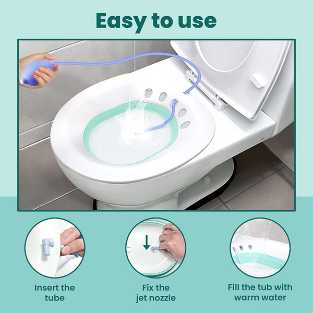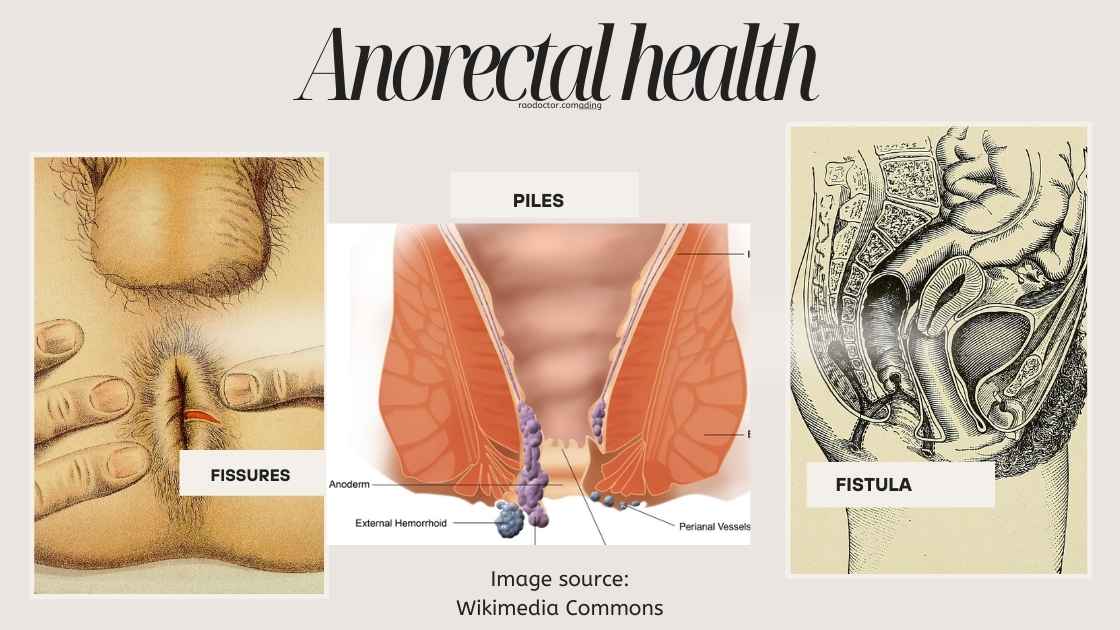Table of Contents
Everything You Need to Know About Fissures, Fistulas, and Piles
Do you ever experience discomfort or pain in your anal region? If so, you may be suffering from an anorectal condition. While these issues may not be the most pleasant topic to discuss, they are more common than you may think.
Fissures, fistulas, and piles [also known as hemorrhoids], are all anorectal conditions that can cause discomfort and pain. But don’t worry, you’re not alone. In fact, millions of people worldwide suffer from these conditions.
In this article, we’ll cover everything you need to know about anorectal health, including the causes, symptoms, and treatment options for fissures, fistulas, and piles.
So, whether you’re experiencing discomfort or just want to learn more about anorectal health, keep reading to become a pro on the topic.
Understanding Fissures, Fistulas, and Piles
A few months back I published an article on 11 Gastrointestinal Diseases and I had mentioned piles as one of the GI diseases. Today, in this article we will learn specifically about anorectal health and diseases.
Anorectal conditions can be difficult to diagnose, and even more challenging to understand. Three common conditions that affect the anus and rectum are fissures, fistulas, and piles.
A fissure is a small tear in the lining of the anus, which can cause pain and discomfort during bowel movements.
You can listen to this podcast for a better understanding of this condition-
A fistula is an abnormal connection between two organs, such as the rectum and the skin, which can also cause pain and discomfort.
Piles, also known as hemorrhoids, are swollen veins in the anus or rectum that can cause itching, pain, and bleeding.
You can listen to this audio for a better understanding of piles-
While these conditions may seem similar, they have different causes and symptoms-
Fissures are usually caused by constipation, diarrhea, or trauma to the anus.
Fistulas are often a complication of an abscess, which is a painful collection of pus in the anal area.
Piles can be caused by a variety of factors, including pregnancy, obesity, and straining during bowel movements.
Causes and Symptoms of Fissures, Fistulas, and Piles
Now that we understand what fissures, fistulas, and piles are, let’s take a closer look at their causes and symptoms.
Fissures
Fissures are often caused by trauma to the anus, which can be the result of constipation, diarrhea, or passing large or hard stools.

Symptoms of fissures include pain during bowel movements, itching, and bleeding. In some cases, fissures can also cause a small lump near the anus.
Fistulas
Fistulas on the other hand, are often the result of an abscess, an infection in the anorectal region that causes a painful collection of pus in the anal area.

Symptoms of fistulas include pain, swelling, and discharge of pus or blood from the anus. In some cases, fistulas can also cause itching and discomfort.
Listen to this audio by clicking to this podcast- Fistula
Piles
Piles are caused by swollen veins in the anus or rectum, which can be the result of straining during bowel movements, pregnancy, or obesity. Have a look at the anatomy [a cross section of the rectum and anus] below.
There is a distinct line called Pectinate or the Dentate line that separates rectum from the anus. Veins above this line that carry blood from rectum and anus towards the heart can get swollen due to persistent compression due to constipation and prolonged sitting in one position.
These then protrude out like a bunch of grapes and can be felt by touch or can be seen by bending forwards. This is called hemorrhoid or piles.

Image Source-Wikimedia Commons
Symptoms of piles include itching, pain, and bleeding during bowel movements. Most of the time, when the swollen veins protrude out [as shown above], they can be seen as well as felt with the hand just outside the anus.
In some cases, piles can also cause a lump near the anus. In most cases they occur due to repeated bursting of these swollen veins and the infection that follows in the burst veins. Over a period of time, they may shrink and shrivel up but can still be felt as a lump due to scarring.
There are 4 stages of piles or hemorrhoids as shown in the image below-

Read more on piles and its stages here- Mayo Clinic on Hemorrhoidal Disease
Diagnosis and Treatment Options for Fissures, Fistulas, and Piles
If you’re experiencing symptoms of anorectal conditions, it’s essential to see a doctor for a diagnosis. Your doctor may perform a physical exam like a proctoscopy, or order imaging tests to determine the cause of your symptoms. Once the cause is identified, your doctor will recommend a treatment plan.
A very important part of the treatment is the Sitz Bath. In this treatment, the patient suffering from any of these three conditions is advised to sit in a tub of warm water. The image below shows what a Sitz bathtub looks like-

This treatment improves blood supply to the affected area/s as well as serve as fomentation to give relief from pain, especially in fissures.
( You can purchase Sitz bathtub online using these Amazon links in your respective countries- India, USA, Canada, UK)
Alternately, it also helps remove stool debris lodged in the fissure and the piles that have burst. You can read about Sitz bath here-
https://my.clevelandclinic.org/health/treatments/24137-sitz-bath
Disclosure: Some of the links used in this article are affiliate links, meaning that if you make a purchase, I will get a commission, at no extra cost to you. Please be rest assured that I only recommend products I genuinely believe in, and trust to be good for you too
Treatment options for fissures may include over-the-counter creams or ointments to reduce pain and inflammation. Your doctor may also prescribe anti-inflammatory pain killers and antibiotics if the fissure is infected. In severe cases, surgery may be necessary to repair the tear in the anus.
Fistulas are often treated with antibiotics and anti-inflammatory to clear up the infection and surgery to remove the abnormal connection.
In some cases, a fistulotomy, a surgery which involves cutting the fistula and allowing it to heal naturally, may be recommended.
Treatment options for piles may include over-the-counter creams or ointments to reduce pain and inflammation. In severe cases, surgery may be necessary to remove the swollen veins. The operation is called Hemorrhoidectomy.
Prevention Tips for Fissures, Fistulas, and Piles
While anorectal conditions can be challenging to prevent, there are steps you can take to reduce your risk. To prevent fissures, it’s essential to maintain regular bowel movements by eating a high-fiber diet and drinking plenty of water. It’s also essential to avoid straining during bowel movements.
To prevent fistulas, it’s essential to practice good hygiene by keeping the anal area clean and dry. It’s also important to treat any infections promptly to prevent complications.
To prevent piles, it’s essential to eat a high-fiber diet and drink plenty of water to maintain regular bowel movements. It’s also important to avoid straining during bowel movements and to exercise regularly to maintain a healthy weight.
Lifestyle Changes
Lifestyle changes can also help improve your overall anorectal health. Regular exercise can help improve bowel function and reduce the risk of these diseases. Maintaining a healthy weight can also reduce the risk of piles and other two conditions.
It’s also important to practice good hygiene by keeping the anal area clean and dry. Avoid using harsh soaps or wipes, which can irritate the skin and cause further discomfort.
Foods to Avoid and Include in Your Diet
Your diet can also play a role in your anorectal health. To prevent these three conditions, it’s important to eat a high-fiber diet that includes fruits, vegetables, and whole grains. This can help improve bowel function and reduce the risk of constipation.
Foods to avoid include processed foods, sugary drinks, and alcohol, which can all contribute to constipation. It’s also important to stay hydrated by drinking plenty of water throughout the day.
Anorectal Health Myths Debunked
There are many myths surrounding anorectal health, which can make it difficult to understand these conditions. One common myth is that these conditions only affect older adults.
While all three conditions are more common in older adults, they can affect people of all ages.
Another myth is that anorectal conditions are caused by poor hygiene. While good hygiene is important to prevent these conditions, poor hygiene is not the sole cause of these conditions.
When to See a doctor
If you’re experiencing symptoms of anorectal conditions, it’s essential to see a doctor for a diagnosis. Symptoms such as pain, bleeding, and discharge can be a sign of a more serious condition, such as cancer. Early diagnosis and treatment can improve your chances of a successful recovery.
Conclusion: Maintaining Good Anorectal Health
In conclusion, anorectal conditions are more common than you may think. Fissures, fistulas, and piles can all cause discomfort and pain, but there are steps you can take to prevent and treat these conditions. Maintaining good hygiene, eating a high-fiber diet, and exercising regularly can all help improve your anorectal health.
If you’re experiencing symptoms of any of these conditions, it’s essential to see a doctor for a diagnosis and treatment plan. With the right care, you can maintain good anorectal health and enjoy a pain-free life.
Useful resources-
Final Words
I hope you have found this article useful. If yes, please share it using the social media icons at the bottom of this article. Alternately, you can Click to Tweet here-
Anorectal Health- Fissures, Fistulas and Piles Share on XMy next article will be on a condition related to the conditions discussed in this article- Constipation. Do sign up and subscribe to get notified as and when a new article is published.

